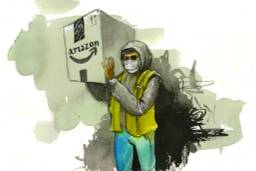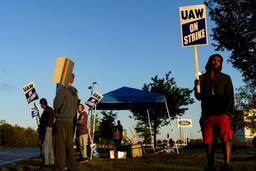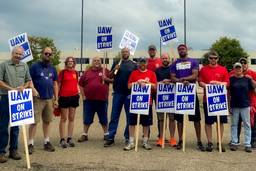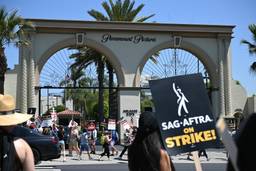“Hardhats vs. Hippies”: How the Media Misrepresents the Debate Over the Green New Deal
Michelle Chen

A recent Politico article about the Green New Deal resolution put forward in February by Rep. Alexandria Ocasio-Cortez (D-N.Y.) and Sen. Ed Markey (D-Mass.) features many grumblings from blue-collar union members about the potential economic disruption and the loss of jobs — even though the resolution calls for union rights and a federal jobs guarantee for workers. The article opens with Robbie Hunter, the president of the State Building and Construction Trades Council of California, which represents 450,000 construction workers and apprentices, who is leading a union-led advocacy campaign called #BlueCollarRevolution. A drastic shift away from oil industry jobs in California, Hunter contends, could “export our jobs, while doing nothing for the end game, which is the environmental.”
The Green New Deal resolution calls for an economy-wide mobilization to achieve a national transition to a zero-carbon future within a decade. The proposal has sparked a vibrant conversation in Congress and throughout the country, resonating with grassroots environmental groups and challenging lawmakers to start talking seriously about decarbonization. Yet despite massive public support, the resolution was predictably stymied in Congress, and has faced skepticism within the Democratic Party and labor movement. Nor has the resolution been greeted with universal praise by the Democratic Party or labor unions. But while some unions express reluctance to hop on the green bandwagon, there’s more to the story than “environmentalists versus blue-collar workers.” Organized labor does not speak with a single voice on climate policy, though the whole movement has deep stakes in the politics of decarbonization, as working-class people’s lives and livelihoods are most vulnerable to climate change.
Jessica Levinson, a law professor who serves on the Los Angeles Ethics Commission, warns in the Politico piece that the Green New Deal “really divides the Democrats on a fault line, which is more of the elites against the working class Democrats who are concerned about losing their jobs.” The article suggests that 2020 presidential hopefuls should be wary of alienating the working-class base — a segment that lost many voters to Trump in 2016, particularly white, working-class voters — by pushing too hard for the Green New Deal.
So a policy agenda intended to address an existential crisis for the world’s environment is framed within the familiar dichotomy between burly blue-collar construction men and tree-hugging liberal elites. It’s a classic American trope that hearkens back to the faux populism of Nixon’s “hardhat” marches against “hippies” during the Vietnam War. Nevermind the fact that the labor movement today is driven by workers in the service industries, women, people of color and immigrants. The media regularly flattens the labor movement into a one-dimensional depiction of a Fordist industrial laborer, frozen in time.
The supposed blue-collar backlash campaign comes in the wake of signs of internecine friction between national labor leaders and pro-green lawmakers. In March, Cecil Roberts, the international president of the United Mine Workers of America, and Lonnie Stephenson, the international president of the International Brotherhood of Electrical Workers, wrote to Congress on behalf of the energy committee of the AFL-CIO, arguing that the Green New Deal was “far too short on specific solutions that speak to the jobs of our members,” and “ma[de] promises that are not achievable or realistic.” Around the same time, AFL-CIO head Richard Trumka — who briefly sat on Trump’s “business advisory council” alongside multinational CEOs before resigning in embarrassment—told reporters that although he acknowledged the urgency of tackling the impending climate crisis, lawmakers should not “leave segments of the economy behind.”
The Politico article follows a number of reports of labor groups chafing at the sweeping goals of the federal Green New Deal resolution, as well as the “Green New Deal Los Angeles,” lamenting the lack of detail about how fossil-fuel dependent industries and workers will be affected. The friction over the resolution does speak to an understandable wariness of the plan’s soaring ambitions. The expansive targets, along with a lack of concrete plans on how to achieve its benchmarks, have stirred fears of unrealistic expectations, and workers have reasonable concerns about whether promises of green jobs will really materialize. With so much at stake, organized labor has a reasonable interest in safeguarding members from potential economic turbulence.
But contrary to Politico’s depiction, skeptics hardly amount to massive working-class opposition to the Green New Deal. The media coverage centers on labor’s fear that workers won’t be provided a fair share of the deal’s achievements. The same question of social equity can be applied to any number of progressive policy proposals that the 2020 presidential candidates have touted, such as Medicare for All or a federal jobs guarantee.
More importantly, though building-trades workers may fit Trump’s image of working-class America, they are not representative of labor or the working class as a whole when it comes to green issues. The future of labor will be helmed by service workers, women, immigrants and people of color. Accordingly, the Green New Deal or other strong climate change policies have won endorsements from SEIU, Los Angeles County Federation of Labor and National Nurses United, along with various locals like New York State Nurses Association and American Federation of Teachers - Oregon. A survey released by Data for Progress this month found that “union membership is one of the factors most highly correlated with support for Green New Deal policies as well as the Green New Deal framework as a whole.”
Backing the Green New Deal is a way to extend union support for working people beyond wages and benefits, because the Green New Deal is a social contract to form the foundation of a sustainable economy. From a practical standpoint, as a dwindling labor movement strives to remain relevant to the working masses, there simply is no bigger bread-and-butter issue than our land, air, water and health. Globally, affluent countries with higher union representation tend to have lower greenhouse gas emissions than less unionized countries.
Working-class migrant communities and communities of color may have a first-hand understanding of how climate volatility affects their work — be they an immigrant nurse whose hometown in the Philippines is facing intensifying typhoons, or a Los Angeles teacher whose students miss school when dirty local air leaves them struggling to breathe. As part of a global proletariat, their struggles reflect the even longer-term challenge of climate justice: seeding a carbon-free future for the global economy. The struggle for climate justice extends beyond the Green New Deal resolution; the ultimate goal is to link the entire world in a compact to decarbonize and to refocus development and industry on sustainability and social equity, rather than profit.
It is shortsighted for the media to present labor’s skepticism toward the Green New Deal as akin to the far-right’s climate skepticism. Globally, a consensus is crystallizing on the left: There is no future in which workers are not on the frontline of climate-driven social transformation, either as survivors, or as agents of change.
Putting the concept of climate justice into practice requires braiding environmental and labor agendas into a unified “just transition” — a comprehensive set of social welfare protections for the workers and communities most impacted by climate policy. As Sara Nelson, president of the Association of Flight Attendants, has pointed out, “Labor has never seen an actual ‘just transition.’” To engage labor with the Green New Deal, Nelson told In These Times last month, policymakers and activists must “make labor central to the discussion, including labor rights, labor protections and labor expertise. … Let’s recognize and engage the infrastructure and experience of the labor movement to make this work.”
By listening to workers, we’d perhaps discover that even the #BlueCollarRevolution might be surprisingly amenable to a climate justice agenda. Robbie Hunter himself wrote in March about a green project he could get behind: He urged the state to invest in building clean mass transit, pointing out that, “Having built most of California’s utility-scale solar and wind generation, we who work in the building and construction trades think it’s time to get real about our ambitious climate goals.”
Despite the media’s insistence that environmentalism remains the province of the privileged, blue collars and green priorities may overlap more than they know. All we need to do is treat Green New Deal like any other labor contract: get everyone around the table and start talking.

I hope you found this article important. Before you leave, I want to ask you to consider supporting our work with a donation. In These Times needs readers like you to help sustain our mission. We don’t depend on—or want—corporate advertising or deep-pocketed billionaires to fund our journalism. We’re supported by you, the reader, so we can focus on covering the issues that matter most to the progressive movement without fear or compromise.
Our work isn’t hidden behind a paywall because of people like you who support our journalism. We want to keep it that way. If you value the work we do and the movements we cover, please consider donating to In These Times.
Michelle Chen is a contributing writer at In These Times and The Nation, a contributing editor at Dissent and a co-producer of the “Belabored” podcast. She studies history at the CUNY Graduate Center. She tweets at @meeshellchen.







